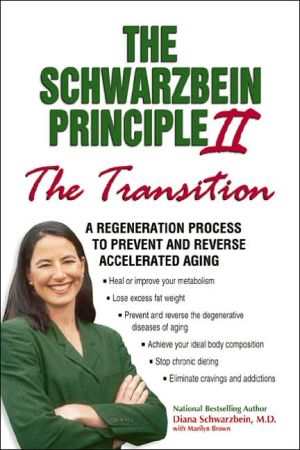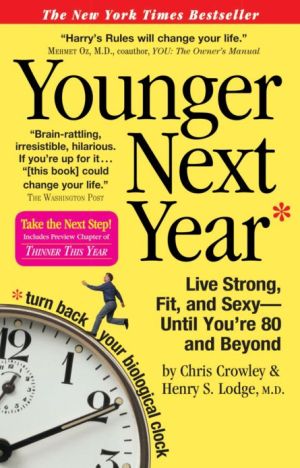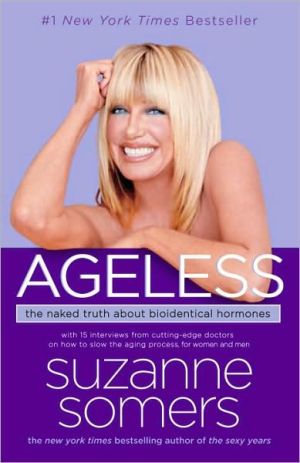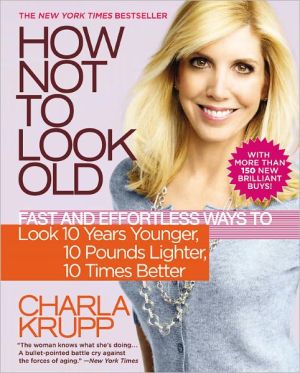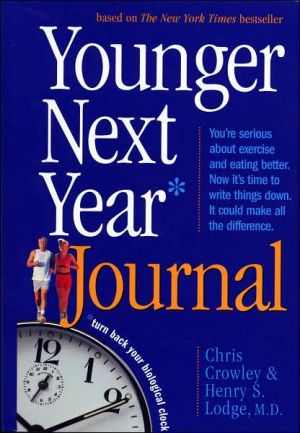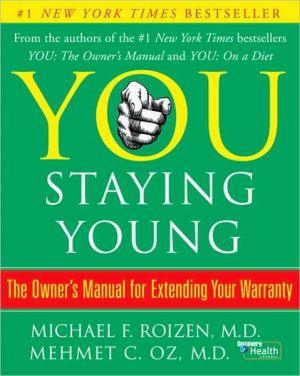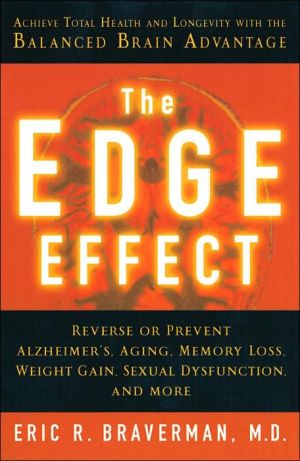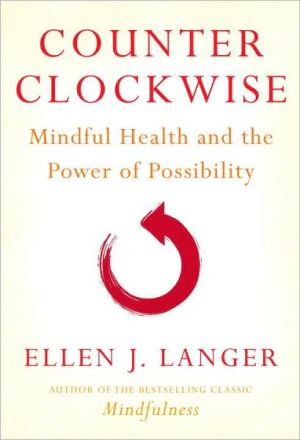The Schwarzbein Principle II, The "Transition": A Regeneration Program to Prevent and Reverse Accelerated Aging
In her very successful book, The Schwarzbein Principle, renowned endocrinologist Diana Schwarzbein introduced her scientifically proven conclusion that degenerative diseases are not genetic, but acquired.\ Many studies have supported this, proving that life expectancy is 75 to 90 percent due to habits and only 10 to 25 percent due to genetics. This means that someone who is genetically destined to die at age 100 may not live past age 60 because of poor habits and lifestyle choices that cause...
Search in google:
This follow-up book to the 250,000-copy best-seller The Schwarzbein Principle shows you how to stop accelerated aging. Publishers Weekly Schwarzbein, founder of the Endocrinology Institute of Santa Barbara, first presented her plan for weight loss and overall well-being in The Schwarzbein Principle. This expanded follow-up is designed to help people manage stress, consume the right combination of nutrients, exercise properly, manage any necessary hormone replacement therapy and avoid toxic chemicals. By controlling these key concerns, Schwarzbein promises readers will feel better, younger and more alert and avoid degenerative diseases associated with aging. Though she cautions people not to expect quick-fix results, some will find it difficult to stick with the Schwarzbein regime when the desired physical changes don't become rapidly apparent (some readers, for instance, might gain weight before they lose it). Readers must identify their particular problems-insulin dependency, adrenaline addiction, etc.-and then modify their current diet accordingly. Meal suggestions will please some dieters-red meat and some sausage is permitted. (Condiments, protein bars and bagels are verboten, however.) Sometimes Schwarzbein's advice is quite specific-"Never eat a protein by itself. Too much protein raises adrenaline/cortisol levels and will cause you to burn out your adrenal glands over time"-and some of her warnings are a little disconcerting. "The more cardiovascular exercise you do, the faster you will age," she writes. Many readers will no doubt benefit from the Schwarzbein plan, but her promises of a radical transformation need to be tempered by more caution. And, since she offers specific advice about hormonal supplements, readers should have a complete physical and blood workup from their physicians before following all of the strategies. (Oct.) Copyright 2003 Cahners Business Information.
Chapter 8\ The Transition\ \ Everyone goes through what I call the transition to restore their metabolism, achieve an ideal body composition and obtain optimum health. The transition is a journey of healing. You can only be in your transition if you are improving your nutrition and lifestyle habits.\ During your transition your hormones will change in response to the nutrition and lifestyle changes you make, and this allows you to heal. However, you will not have balanced hormones immediately-balanced hormones do not occur overnight. There are sequential steps of healing that everyone must take.\ When you initiate your transition process by improving your habits, your body will begin to rebalance its hormones. Your body will also rebuild all its functional and structural biochemicals that were not made efficiently during your previous poor habits. The more damaged your current metabolism, the longer it will take for this process to be completed.\ By taking the time to follow the necessary steps in the SPII program to balance your hormones, you will heal your metabolism. When you have healed your metabolism, you are primed to lose fat weight, if needed. Once you have lost all your stored fat, you are through your transition.\ The Four Transition Stages\ For most people, the transition to a healthy metabolism and optimal health consists of four main stages:\ \ Initial starting point\ \ Healing phase\ \ Fat-burning phase\ \ Healed state\ \ \ \ \ Here is what to expect as you journey through your transition to health. You begin at your initial starting point and then enter a healing phase that may consist of a self-medicating phase. Then you enter a fat-burning phase-if you need to burn fat before you finally reach a healed state.\ Depending on your current metabolism, your body may skip the healing and/or fat-burning phases.\ Let's look at each stage in more detail.\ 1. The Initial Starting Point\ The initial starting point is your current metabolism type and age when you start improving your habits and begin entering your transition. Listed below are the four metabolism types an individual can have:\ 1. Insulin-sensitive with healthy adrenal glands\ 2. Insulin-resistant with healthy adrenal glands\ 3. Insulin-sensitive with burned-out adrenal glands\ 4. Insulin-resistant with burned-out adrenal glands\ These metabolism types are not genetic but acquired. Everyone begins life insulin-sensitive with healthy adrenal glands.* It is only after years of poor nutrition and lifestyle habits that you may become insulin-resistant or have burned-out adrenal glands-or have both conditions.\ Your age and how long you have had your current metabolism affect the duration of your transition. The older you are and the longer your metabolism has been damaged, the longer it will take for you to complete your transition.\ Your Goal\ Your goal is to stay or become insulin-sensitive and to have healthy adrenal glands or to heal them. Therefore, the goal is to have a metabolism where you are insulin-sensitive with healthy adrenal glands.\ If you are starting out with this metabolism, your transition to healing requires improving your daily habits to keep from damaging your metabolism.\ If you start out insulin-resistant with healthy adrenal glands, your goal is to become insulin-sensitive and keep your adrenal glands healthy.\ If your current metabolism is insulin-sensitive with burned-out adrenal glands, your goal is to stay insulin-sensitive and heal your adrenal glands.\ If you are insulin-resistant with burned-out adrenal glands, you must heal both sides of your metabolism to reach your goal of insulin-sensitive with healthy adrenal glands.\ Insulin-Sensitive\ You are insulin-sensitive if your body responds to all the actions of insulin, including the ability to make and store fats. Refer to chapter 5 for an expanded explanation of what insulin does. Note, however, that just as with insulin resistance, you can gain fat weight around your midsection when you are insulin-sensitive. Therefore, do not confuse having excess fat weight around your midsection with being insulin-resistant (see below).\ Insulin-Resistant\ You are insulin-resistant if you have an elevated fasting insulin level with one or more of the following signs/disorders: excess fat weight around your midsection, high triglyceride levels and low HDL levels, high blood pressure, Type II diabetes, and/or coronary artery disease. You will probably need to ask your physician to order a fasting insulin and cholesterol profile in order to determine if you are insulin-resistant or not. Or visit my Web site at: www.SchwarzbeinPrinciple.com, to find out how you can be tested.\ There are three paths that lead to insulin resistance:\ \ Years of high insulin levels due to poor nutrition and lifestyle habits.\ \ Years of high adrenaline and/or cortisol levels due to poor nutrition and lifestyle habits.\ \ Years of high insulin, adrenaline and cortisol levels due to poor nutrition and lifestyle habits.\ \ \ \ \ If you recognize that you are on any of these paths, now is the time to change your habits!\ Are you insulin-sensitive, insulin-resistant or on the way to becoming insulin-resistant? Identify yourself here (check one):\ ___I am insulin-sensitive.\ ___I am insulin-sensitive on the way to insulin-resistant.\ ___I am insulin-resistant.\ ___I am not sure, so I will ask my physician to order blood tests.\ Are Your Adrenal Glands Healthy or Burned Out?\ Your adrenal glands make both adrenaline and cortisol. Years of oversecreting these two hormones can burn out your adrenal glands. If you have burned out your adrenal glands, you need to restore their function before you can achieve optimum health.\ You have healthy adrenal glands if you can stop all your high-adrenaline and/or cortisol habits cold turkey without experiencing withdrawal symptoms and completely falling apart emotionally and/or physically.\ If you are addicted to white sugar, caffeine, nicotine, diet pills, alcohol, overexercising and/or street drugs, or if you are always tired, have a "fuzzy" brain or cannot handle stressful situations, your adrenal glands are probably burned out.\ Your adrenal glands are burned out if your adrenal saliva test shows low cortisol levels throughout the day. Ask your physician to test your adrenal glands or visit my Web site, www.SchwarzbeinPrinciple.com, to find out how you can be tested.\ Do you have healthy or burned-out adrenal glands? Are you on the path to burning them out? Identify yourself here (check one):\ ___I have healthy adrenal glands.\ ___I have healthy adrenal glands, but I am on the path to burning them out.\ ___I have burned-out adrenal glands.\ ___I am not sure, so I will ask my physician to test my adrenal gland function through saliva testing.\ Now, put together your insulin status and your adrenal gland state to identify your current metabolism type (check one):\ ___I am insulin-sensitive and have healthy adrenal glands.\ ___I am insulin-resistant and have healthy adrenal glands.\ ___I am insulin-sensitive and have burned-out adrenal glands.\ ___I am insulin-resistant and have burned-out adrenal glands.\ Note: If you are not sure what your current type is and you want to start this program before your laboratory tests are back, consider yourself insulin-sensitive with burned-out adrenal glands.\ 2. The Healing Phase\ In the healing phase your body will repair itself from the damage caused by years of poor nutrition and lifestyle habits. You always have higher insulin than adrenaline/cortisol levels during this phase because this is a rebuilding time.\ It may seem as if you are in suspended animation during this phase because though you are healing, it doesn't feel or seem that way. As you improve your habits, you are rebuilding your biochemicals at a much higher rate than you are using them up, and this causes you to feel tired and to gain fat weight.\ Your Current Metabolism Is Revealed During the Healing Phase\ During the healing phase you expose your current metabolism because your hormones will react to your new and improved nutrition and lifestyle habits and reflect their true state.\ If you are insulin-sensitive, your insulin levels will fluctuate appropriately with your carbohydrate intake; if you are insulin-resistant, your insulin levels will stay high while you are healing.\ For example, if you are insulin-sensitive, your fasting insulin levels are within normal ranges, and when you eat carbohydrates, your levels rise to match your carbohydrate intake so your body can process the food. Once you process your food, your insulin levels come back down to normal.\ But if you are insulin-resistant, your fasting insulin levels are already higher than normal, and they will stay high, even if you improve your eating habits, until you have become insulin-sensitive again.\ If your adrenal glands are healthy, your adrenaline/cortisol levels will respond appropriately to your habits; if your adrenal glands are burned out, your adrenaline/cortisol levels will stay low until your glands have had a chance to heal. You have worn them out and depleted their ability to respond as they would under normal circumstances.\ What Happens to Your Hormone During the Healing Phase\ Here is what happens to your hormones during your healing phase-depending upon your current metabolism.\ If you are insulin-sensitive with healthy adrenal glands, your hormones will immediately become balanced when you improve your habits; therefore, you are instantly through your healing phase.\ If you are insulin-resistant with healthy adrenal glands, your insulin levels will remain high despite your improved habits until your body has a chance to heal and you become insulin-sensitive again. However, your adrenaline/cortisol levels will normalize immediately.\ If you are insulin-sensitive with burned-out adrenal glands, your insulin levels will respond appropriately to your improved habits, but your adrenaline and cortisol levels will stay low while your adrenal glands heal; they will normalize when you have completely healed.\ If you are insulin-resistant with burned-out adrenal glands, your insulin levels will remain high, and your adrenaline/cortisol levels will remain low. As you heal, your insulin and adrenaline/cortisol levels will slowly normalize.\ How Your Body Heals\ Unfortunately, your body will not start working efficiently the moment you improve your habits. As previously stated, you did not damage your metabolism overnight, and you will not heal it overnight. During the healing phase, you are still hormonally out of balance. As your body begins to correct this imbalance, you may experience any number of disturbing symptoms.\ For example, as your adrenaline/cortisol levels drop, you may feel withdrawal symptoms such as fatigue, irritability and depression. As your insulin levels rise, you may gain fat weight and/or experience salt and water retention.\ The more damaged your current metabolism is, the longer you will need to stay in the healing phase and the more fat your body produces. In fact, as your ratio of insulin to adrenaline/cortisol increases, your symptoms will worsen.\ As awful as this may sound, this is your body's only way to heal. So do not be put off by the healing phase-it is simply a reflection of the damage that came before it.\ Since insulin is a rebuilding hormone and adrenaline and cortisol are using-up hormones, you can only heal from years of using up your biochemicals by rebuilding them-this means higher insulin-to- adrenaline/cortisol levels. Unfortunately, even though you begin to improve your habits, the damage has already been done by your previous poor habits. Therefore, you will not instantly reap the rewards of your better habits.\ For example, when people stop smoking, they may gain a lot of fat weight and feel tired and listless. They usually tell me they never should have stopped smoking because now they feel lousy and are fat besides.\ What they don't realize is that the only way their bodies can heal is by raising their insulin levels higher than their adrenaline levels, so they will gain fat weight as their bodies heal from years of smoking. The damage occurred while they were smoking, not after they stopped. The only way to avoid having to heal from smoking is to never smoke in the first place.\ If you are a smoker, the best thing you can do for your health is to quit and begin healing from years of using up your biochemicals more than rebuilding them due to nicotine use.\ There is a subpart to the healing phase: the self-medicating phase. The self-medicating phase occurs whenever you do anything that raises your adrenaline/cortisol levels closer to your insulin levels.\ The Self-Medicating Phase\ Since your insulin levels must be higher than your adrenaline/cortisol levels for your body to heal, it does not always feel very good to be in the healing phase of your transition. It is during this time that the self-medicating phase becomes important in keeping you on the path to restoring your metabolism.\ In this phase you use one or more of the following to make yourself feel good enough to continue your healing process: small amounts of stimulants, alcohol and refined sugars. Overexercising is also a form of self-medication. Self-medicating makes you feel better in the short-term because using up your biochemicals always feels better than rebuilding them.\ In the self-medicating phase you still have higher insulin than adrenaline/cortisol levels, but you narrow the gap between your rate of rebuilding and using up. Your self-medicating habits raise your adrenaline/cortisol levels closer to your insulin levels, and you prolong your transition because self-medicating keeps you closer to your current metabolism than to your goal metabolism.\ It is sometimes necessary to self-medicate to get through your transition, especially if you begin with burned-out adrenal glands. The How To section outlines the best ways to self-medicate if you need to.\ Do not make the mistake of thinking you are self-medicating if you have not changed any of your habits! You cannot "be good" part of the time and revert to your poor habits the rest of the time. If you over- self-medicate and your adrenaline/cortisol levels get higher than your insulin levels, you will no longer be in your transition process, and you will continue to damage your metabolism.\ 3. The Fat-Burning Phase\ The fat-burning phase of the transition occurs after your body has done all its rebuilding in the healing phase. The main changes to your body composition during the healing phase is an increase in lean body tissue, such as muscles and bones rather than a decrease in fat weight per se. However, do not get discouraged, you will have started to burn off some of your excess fat-weight during the healing phase and are now ready to burn off the rest.\ You begin your fat-burning phase only after your hormones are completely normalized and your metabolism is healed. Only then is your body ready to burn off the rest of your stored fat if it needs to. All your symptoms of fluctuating adrenaline, cortisol and/or insulin levels will be gone, and you will feel great. During this phase you will be rebuilding and using up your functional and structural biochemicals again at an equal rate.\ 4. The Healed State\ The healed state is when all of your hormones are balanced, your metabolism has healed and you have achieved your ideal body composition. You are now through your transition and have achieved the ideal current metabolism type. You are insulin-sensitive and have healthy adrenal glands. When you are in this state, you are rebuilding as many biochemicals as you are using up and have the lowest risk for the degenerative diseases of aging. Your goal now is to keep your hormones balanced so that you do not damage your metabolism again.\ Timing Is Everything\ The time it takes to go through the transition is different for everyone. The transition to a healthy metabolism can occur very quickly, or it can take months or years to complete.\ If you have a healthy metabolism, you will be able to complete your transition quickly once you change your nutrition and lifestyle habits. If you begin with a badly damaged metabolism, however, it may take you years to completely heal. But you can heal. It is never too late. You are closer than you think.\ Why You Do Not Lose Weight Right Away\ During the transition from a damaged metabolism to a healed one, you will become healthier-but you will not have the body composition you want right away. Why? Because you first need to heal your metabolism before you can achieve your ideal body composition. You need to be healthy to lose weight, not lose weight to be healthy. It is only when you have completely healed your metabolism that you are primed for losing all your excess storage fat.\ Do not confuse losing weight according to the bathroom scale with losing excess fat weight. If you quickly lose weight while your metabolism is still damaged you are not just losing storage fat-you are also losing your functional and structural proteins and fats and causing further damage to your metabolism. And since protein weighs more than fat, you may think that the lower number on the scale is a good thing when it is not.\ The key to becoming and staying healthy is to burn off your storage fats while retaining your functional and structural proteins and fats.\ It Takes Time to Heal\ The time it takes to heal your metabolism is normal and unavoidable. You may as well start to heal now; there is no alternative. The sooner you start your transition, the sooner you will get through it and obtain optimum health.\ For those of you who are starting off with a damaged metabolism, you cannot escape the time it takes to heal, but you will have the advantage of knowing what you need to do to shorten your transition time. My transition took a long time because I began with a badly damaged metabolism, and I did not know what I needed to do to heal myself.\ Dr. Schwarzbein's Transition\ My transition was not a typical one. I spent seven years healing my metabolism because I did not have a specific plan to follow. This was during the late '70s and early '80s when the recommended food plan was a higher carbohydrate diet. Because I switched from eating refined sugars to eating complex carbohydrates and unbalanced meals, I became insulin-resistant while I was still in the process of healing my adrenal glands.\ As I healed, I went from insulin-sensitive with burned-out adrenal glands to insulin-resistant with burned-out adrenal glands, then to insulin-resistant with healthy adrenal glands and finally to insulin-sensitive with healthy adrenal glands. Because I did not know what I needed to do to heal, I took many unnecessary detours and ended up with all the different current metabolism types. Along the way I tried different eating programs until I finally hit upon the balanced food program that enabled me to heal completely.\ I am going to explain my complicated transition by describing the changes in my major hormones and how they affected me throughout the different stages of my healing. Sometimes adrenaline and cortisol are not linked to each other, but in my case they still were; so if adrenaline went up, cortisol did, too. When adrenaline went down, so did cortisol.\ Therefore, to simplify, I will discuss what happened to me in terms of adrenaline versus insulin only. But remember, all my hormones were involved.\ My own nutrition and lifestyle habits-eating lots of refined sugary foods and overdoing cardiovascular exercise-initially stimulated the release of large amounts of adrenaline. This is why I was so thin; adrenaline causes your body to use up its biochemicals. However, these same habits also made me very unhealthy. From years of using up more than rebuilding my biochemicals, my body was used up, too.\ I thought that I had the best metabolism in the world. I could and did eat thousands of calories of refined sugar a day, and I did not gain an ounce. But in reality I had already badly damaged my metabolism. I was not eating enough of the right foods for my body to rebuild. Accessing and using up your biochemicals is only half of what it takes to have a healthy metabolism; the other half is eating well and rebuilding. Because I was using up my biochemicals at a rapid rate and barely rebuilding, I did not have a healthy metabolism even though I stayed thin.\ My body was also secreting high amounts of insulin in response to my high-adrenaline levels to prevent me from completely wasting away. This was a good thing. When adrenaline/cortisol levels rise, insulin levels also rise to modify the amount of using up of your biochemicals that is occurring in your body. If your body were to continue to use up its biochemicals because of high adrenaline/cortisol levels, and you did not have this insulin stopgap, you would die. So your body secretes more insulin in an attempt to keep you alive longer. An example of this built-in survival mechanism is when you go on a diet and eat fewer calories. You initially lose weight rapidly, but the longer you restrict your food intake, the slower your rate of weight loss. In fact, you may even stop losing weight. In this case, your body senses it is using itself up too quickly, so it secretes more insulin to counteract rapid weight loss. This is a very powerful survival instinct and is what kept me alive despite my poor eating habits.\ The amount of refined sugar that I ate raised both my adrenaline and insulin levels, but my adrenaline levels rose higher than my insulin levels. However, because refined sugar cannot be turned into functional or structural biochemicals, the higher amounts of insulin I secreted could only keep me from using up all my biochemicals completely-it could not help me rebuild. I was using up faster than I could rebuild.\ My Initial Starting Point\ When I was sixteen, I was all skin and bones. I was five-foot-eleven, weighed 125 pounds and was very underweight and unhealthy. I had very little muscle and no fat on my body at all. I had asthma, chronic bronchitis, irritable bowel syndrome and cystic acne. I was hormonally out of balance with both high adrenaline and high insulin levels.\ Because I did not think that I would live a long time if I continued to be this unhealthy, I began to look for some solutions to my health problems. This was the initial starting point of my transition.\ I was insulin-sensitive with burned-out adrenal glands, but my hormones did not reflect this until I entered the healing phase, which exposed my underlying physiology.\ Entering My Transition\ I began to improve my eating habits in an attempt to improve my health. When I began adding other foods to my diet besides refined sugar, my body perceived that the "starvation" crisis was over and it was time to rebuild.\ I had entered my healing phase and my body began rebuilding more than using up. But because I was eating a high complex-carbohydrate diet, I mostly rebuilt storage fats and not functional or structural proteins and fats.\ In terms of my hormones, my adrenaline levels came crashing down and dipped even lower than normal, and my insulin levels rose even higher because I was eating so many complex carbohydrates. I was addicted to refined white sugars, and this meant that my adrenal glands were already burned out. If they hadn't been burned out, my adrenaline levels would not have dipped so low.\ The fact that my insulin levels stayed high was initially a reflection of my high-carbohydrate intake. If I had been eating a balanced diet, my insulin levels would have normalized. As it was, my insulin levels were very high and my adrenaline levels were very low.\ I developed insulin-resistance over the next few years because I was eating too many complex carbohydrates and not enough proteins. I started off insulin-sensitive with burned-out adrenal glands, and then I became insulin-resistant with burned-out adrenal glands, but I did not have this type of current metabolism for very long. My adrenal glands were already in the process of healing because I had stopped eating refined sugars, which was the main reason my adrenal glands had burned out to begin with.\ Because I had badly damaged my metabolism for many years before I improved my habits, and because I ate large amounts of complex carbohydrates, I gained a lot of fat weight throughout my midsection. I also experienced significant water retention with bloating and ankle swelling.\ I had learned that you can only hold onto water if you have salt in your body, so I went on a two-gram salt diet to lessen my swelling. This did help, but it did not treat the real reason I was retaining fluids-high insulin levels.\ I was very unhappy about gaining fat weight, but what really made my healing phase difficult was that I was always fatigued. I did not know that running on high adrenaline for all those years was one of the reasons I was so tired now.\ Because my adrenal glands were burned out, nonvital functions such as a sense of well-being and fertility shut down. My body kept me alive, but feeling good was not its priority and neither was making a baby.\ The other thing that made me so fatigued was all the complex carbohydrates I was eating. The combination of higher insulin levels, from eating too many carbohydrates, and very low adrenaline levels, from burned-out adrenal glands, made me extremely tired.\ Despite my fatigue and weight gain, I recognized that I felt slightly better. I was much calmer, and my nervous edge was gone; I knew deep down that I was doing the right thing by trying to eat better foods.\ This does not mean that I did not think of going back to my old ways. I had many thoughts about going back to eating cotton candy, Pixi-Stix and my own milky, sugary oatmeal so that I could have energy-even nervous energy-and be thin again. But something kept me from doing this. I believe that I did not go back to my old ways because I realized that I had been killing myself by eating so poorly.\ It may sound as if I easily intellectualized my healing phase, but it was an ongoing internal battle. I did give in many times to the "noise" in my head that demanded sugar for energy. Each time I did, however, I felt so much worse afterwards that after a while all that negative reinforcement made it easier to resist my cravings.\ By experimenting with different meal plans, I noticed that I felt better and was less bloated when I ate balanced meals. I started to eat this way consistently about four years into my transition. A year later I had completely healed my adrenal glands, but I was still insulin-resistant.\ Self-Medicating Phase\ I struggled during my healing phase because I had no idea what was happening to me. I was eating better, but I was gaining weight and feeling tired all the time. This was the opposite of what I expected to happen.\ I began to notice that the only time I felt well was when I was exercising. Even though I had been exercising before, I now got to the point where I was spending three to four hours a day doing cardiovascular exercises just so I could feel normal.\ Because my adrenal glands were healed at this point, I was able to feel better by increasing my exercise, but I did not know that I was slowing down my own healing process because exercise raises adrenaline levels. In fact, I felt just the opposite. I thought that more exercise would help me lose the fat weight I had put on and would be healthy for me. But I was forcing my body to use up my biochemicals again-through exercise this time, not by eating excessive amounts of refined sugars. This was my self-medicating phase.\ Luckily, because I was still improving my nutrition habits throughout my self-medicating phase, I did not go back to my initial starting point of higher adrenaline than insulin levels. Therefore, I was still building more than using up my biochemicals, but at a much slower rate.\ When I was not exercising, I felt tired. I was not a caffeine or alcohol person and did not add to my self-medicating by also using these toxic chemicals in order to feel better. I just accepted the fatigue because I could not exercise all day long.\ If I had used a lot of caffeine or alcohol early on and increased my exercise to self-medicate, my adrenaline levels would probably have risen higher than my insulin levels again-and I would have returned to my initial starting point.\ The Fat-Burning Phase and the Healed State\ Fortunately, I had to decrease my daily exercise routine because I was in my third year of medical school and no longer had the time to exercise three to four hours a day. Inadvertently, I stopped self-medicating.\ At this point, two and one-half years had passed since I had begun eating balanced meals. Six and one-half years had passed since I had begun to improve my nutrition and lifestyle habits, and my metabolism had completely healed. I was insulin-sensitive with healthy adrenal glands. My hormone levels were normal, and I began the fat-burning phase of my transition.\ During this phase, I felt completely better and had all the energy I needed-but I still carried excess fat weight around my middle. As I continued through the fat-burning phase, I kept my muscle mass and burned off all my stored fat. Seven years after starting my transition my hormones were all balanced, my metabolism was healed, and I had achieved my ideal body composition. I was through my transition.\ I know now that if I had been following the SPII program, I would have been able to shorten the time it took for me to heal because I would not have become insulin-resistant. But it took me years to find the right nutrition program and to stumble upon all the necessary lifestyle changes I needed to make. It still would have taken years for me to heal-because I started off with such a badly damaged metabolism-but it would have
\ From Barnes & NoblePhysician Dr. Diana Schwarzbein specializes in the science of metabolic healing. Her follow-up to The Schwarzbein Principle II goes beyond diets to offer a regeneration process designed to prevent and reverse accelerated aging. Citing recent research that indicates that longevity depends mostly on habits, not gene pools, she provides her strategy to stop the degenerative diseases of aging.\ \ \ \ \ Publishers WeeklySchwarzbein, founder of the Endocrinology Institute of Santa Barbara, first presented her plan for weight loss and overall well-being in The Schwarzbein Principle. This expanded follow-up is designed to help people manage stress, consume the right combination of nutrients, exercise properly, manage any necessary hormone replacement therapy and avoid toxic chemicals. By controlling these key concerns, Schwarzbein promises readers will feel better, younger and more alert and avoid degenerative diseases associated with aging. Though she cautions people not to expect quick-fix results, some will find it difficult to stick with the Schwarzbein regime when the desired physical changes don't become rapidly apparent (some readers, for instance, might gain weight before they lose it). Readers must identify their particular problems-insulin dependency, adrenaline addiction, etc.-and then modify their current diet accordingly. Meal suggestions will please some dieters-red meat and some sausage is permitted. (Condiments, protein bars and bagels are verboten, however.) Sometimes Schwarzbein's advice is quite specific-"Never eat a protein by itself. Too much protein raises adrenaline/cortisol levels and will cause you to burn out your adrenal glands over time"-and some of her warnings are a little disconcerting. "The more cardiovascular exercise you do, the faster you will age," she writes. Many readers will no doubt benefit from the Schwarzbein plan, but her promises of a radical transformation need to be tempered by more caution. And, since she offers specific advice about hormonal supplements, readers should have a complete physical and blood workup from their physicians before following all of the strategies. (Oct.) Copyright 2003 Cahners Business Information.\ \
